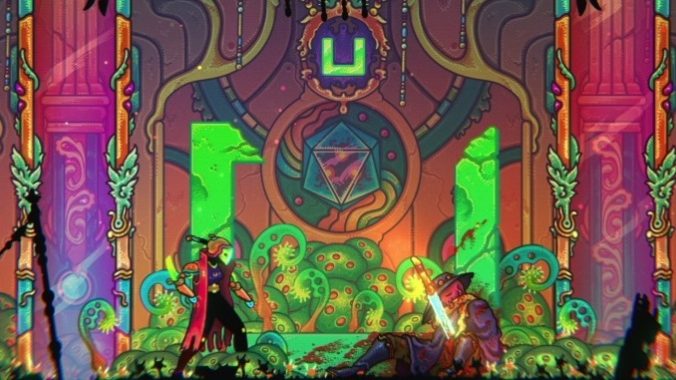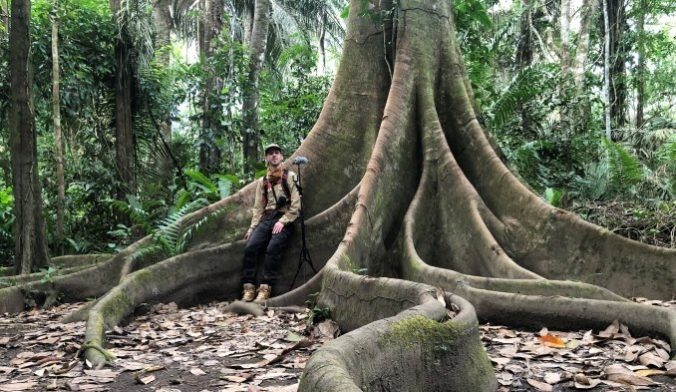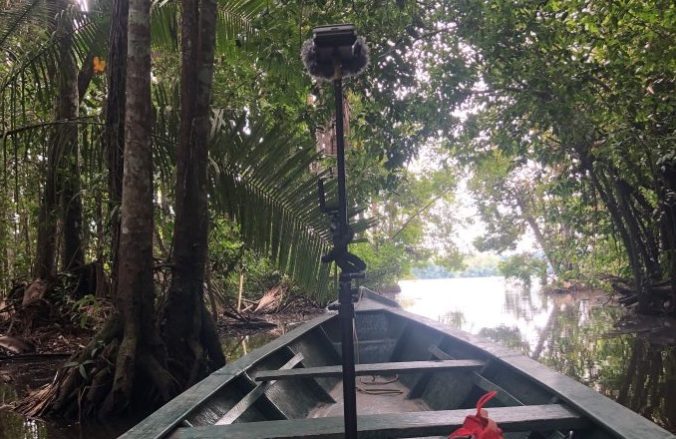
Few games have had the lasting impact on the medium as Metroid, whose signature style of taunting, recursive game design has inspired an entire subgenre of action games. There are so many independently produced games inspired by Metroid and its fellow ’80s action series Castlevania that it’s almost become a cliche at this point. You see these games so much because the core design concepts continue to hold up well into their fifth decade, and also because that style of action can support almost any aesthetic and narrative. Take Ultros, for instance; with art from Hotline Miami‘s Niklas “El Huervo” Åkerblad and music from the ambient composer Ratvader (aka Oscar Sidoff Rydelius), Ultros is a psychedelic smorgasbord with a South American bent, created by artists from Gothenburg, Sweden. It doesn’t look or sound like any other Metroid acolyte you’ve ever seen, but if you’re at all familiar with the genre you’ll recognize its precepts in action.
As timeless as that style of design is, Ultros is defined by Åkerblad’s hallucinogenic art and Ratvader’s ambient score. Psychedelic games are somehow still rare enough to stand out whenever they come down the pass, and El Huervo and Ratvader’s work combines seamlessly to create one of the more unashamedly trippy games in recent memory.
Paste recently spoke to Ratvader about his music for Ultros, a creative process that took him from the Swedish island that Ingmar Bergman once lived on, to the Amazon rainforests in Peru, where he recorded instruments like whistling jars and bone flutes. It’s a fascinating look into one of the most unique videogame scores of the era. And to really help you understand what Ratvader is talking about, you can listen to an exclusive 23 minute sampler of his work from the game.
Paste: How long have you been working on Ultros?
Ratvader: It’s been six years, crazy enough. It’s been a long, long journey. But then obviously, I’ve worked on other games in between, and like, you know, not full full time. But from the initial just like, “Okay, this would be cool,” to where we are today. It’s almost six and a half, seven years.
Paste: How much does the finished product reflect your original vision? Like, how did it change during those six years?
Ratvader: We just put out the second single of of the game. And that one is, I mean, the cello I recorded on that one is the same as the ones I did starting the process. The first pitch footage basically was Niklas Åkerbald’s art and my ambient music and sound effects and nothing else. That core that we found and sort of fell in love with that we wanted to kind of try to perceive and, you know, succeed with is still there for sure. But then, of course, you know, things happen, there are new enemies, and we need more music over here and blah, blah, blah. But no, I think we’ve stayed super honest to the core of what we had. And also, I actually remember us talking about the cello that has a big role in the game where we were like, okay, but we know this might take some time. So let’s go for something that won’t go out of style.

Paste: I see that some of the music was recorded, at least in part, in the Amazon rainforest in Peru. Is that just nature sounds or something more involved? Like, did you have a mobile recording unit with musicians out in the rainforest?
Ratvader: I mean, not that far, but actually close in one way. Like, because actually, yeah, in the sampler that you guys are going to showcase, the first song there is called “Gardner’s Pilgrimage” and Gardner is one character in the game that is sort of like the environmentalist person who knows all about plants and seeds and all fun things. He was one of the characters that I went deeper within, sort of, and sort of did this pilgrimage. So I actually recorded stuff on Gotland, an island here in Sweden. And that was actually me bringing a microphone sitting at the beach recording, like, a melodica, and that went into the game. But in Peru, it was mostly I also did sound design for the game, most of the sound design. So in terms of actually recording outdoors and in the rainforest, it was mostly capturing, you know, birds and animals and ambiences and stuff. But then also I hooked up and met some amazing musicians and people in Peru, and I rented a studio there. And then flutes were recorded, traditional instruments of different ceremonies, and also specifically a lot of the whistling jars. I don’t know if you’re familiar with those, but it’s one of the biggest reason actually also for going [to Peru].
Paste: Tell me more about the whistling jars.
Ratvader: So like in Sweden we have these kinds of things [holds up a water whistle], where you put water inside. And then when you blow it would be like slurping sounds because the audio goes through the water. And the bubbles would be like [makes the sound of a water whistle], you know. There was this amazing tradition in Peru long before the Incas, because they were apparently super great with pottery overall. But what they did was that they mimic different animal sounds by making larger versions of these [whistles], like super big. Usually they would have, like, two chambers almost. So they would be like one chamber here and one chamber here. So as they would move the whistling jar, the water will go through and push through the air and push out the air and the whistling jar would then make the sound that they wanted. So they have tons of these, it’s super fascinating and interesting. You know, mimicking wolves, mimicking birds, monkeys. We recorded those with a special microphone that can record up to 96,000 kilohertz to pitch down and find whatever stuff is in between there. But yeah, that’s a rabbit hole to go down, for sure.

Paste: Why was it important to record some of the sounds in Peru itself?
Ratvader: I mean, so, you will experience the game and find that there is a nature core to it. And the nature core was super important for me, and I think for all in the team. But yeah, so that kind of came kind of naturally, that that was an important part that I really wanted to honor and go as deep as I could. So yeah, it was a dream for me to go there. I’ve done a lot of field recordings over the years in other countries as well, but obviously, Peru and the rain forest when it comes to you know, forest, and I mean, it’s like the place to be. So yeah, it felt like honoring that in some sense. But then also curiosity and just like, the thing we got out of it was, it’s a memory for life for sure. And hopefully, you know, that will transcend into the player somehow even though some of it is very, like, you know, subconscious and hidden, sort of, but also so that if they don’t get the message of what’s happening, maybe the, you know, undertone of just environmental stuff will be there in the soundtrack and the sound design.
Paste: Cool. So I see you also use a bone flute on the soundtrack. Have you ever used instruments made out of bone before?
Ratvader: No, no, that was so, so fascinating. Yeah, like bone flutes, and also they had made some out of the con–I always forget the name, the bird, the super big one–yeah, the condor. They’d take the feather and then the end of it, sort of where I guess it goes into the bird, they would just play like on that thing. So yeah, super. Very interesting and very, like cultural differences, but no, never [played bone] before, but it was very intuitive. And the sound of some of the stuff was just so cool as well. So really amazing.
Paste: Beyond the music of Peru, what were some of your inspirations for the score and some of your ambitions for it?
Ratvader: Yeah, as I said, the first song on the sampler that we will listen to, “Gardner’s Pilgrimage,” the person was inspirational in the sense… obviously, it’s a bit boring talking about it, but periods of Ultros was made when there was a pandemic. We tried to make the most out of that and realized that there were a lot of cabins in Sweden–like, Sweden went quite easy on, you know, what people were allowed to do, I’ve understood from other countries. So we took the moment and opportunity, me and Niklas, to do some, like, staycation-ish, renting cabins and going and working from there. So a lot of it has been made, and a lot of the music was made, especially “Gardner’s Pilgrimage,” on an island called Gotland, which is like, I guess if you’re familiar with movies,, Ingmar Bergman, like the most famous director from Sweden, he was working out there. And also Tarkovsky, who did Stalker and The Mirror, was also working on this island. So we were sort of like, okay, let’s check out the vibe and see what’s going on out there. And that was the place where I actually recorded, like, some stuff outdoors. But also Gothenburg is on the west coast. We have an archipelago here that is just out of this world. I think I’m biased, of course, but it’s very special. So we would also go out there to different locations. And we would hike through the day on sunny winter days–you know, it’s not a lot of those. We would hike during the day, and then we would go back into the cabin and just write and use whatever we recorded. And obviously, [we were inspired] by all kinds of movies, books, and films and games and everything. But yeah, just being out in environment and the nature specifically, I would say for sure.
Paste: So I’d think you’d obviously want to try to, you know, match the visual aesthetic of the game, somehow, but like, how do you do that with El Huervo’s psychedelic artwork? What does that art make you hear? And how do you capture those sounds?
Ratvader: I’m like, what am I supposed to do with this? There’s nothing here for me to do. It’s perfect. I mean, obviously, there was a lot of experimentation going. Like some of the early–like, it was a weird thing, where I think some of the music became quite busy in the sense that there’s a lot of things going on, if you listen to it closely. But at the same time, it needed to take a little bit of a backseat, because there were times when the music was too… like it couldn’t go too overboard, because then, you know, impressions would just be a little bit too much. But I mean, I’m very lucky to have, like, a similar mind to Niklas. So most of the things I tried out and showed to him, he was just like, this is cool. Yeah, it was interesting, challenging, fun.
Ultros comes out for PlayStation 5, PC, and PlayStation 4 on Feb. 13. You can currently play a demo as part of Steam Next Fest.

Senior editor Garrett Martin writes about videogames, comedy, travel, theme parks, wrestling, and anything else that gets in his way. He’s also on Twitter @grmartin.